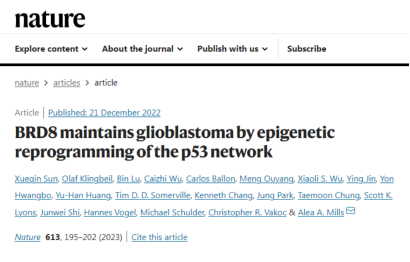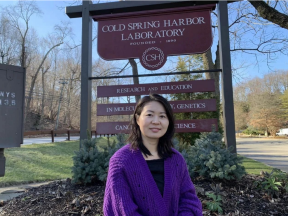Please click the button below to go to our email login page
|
The first Nature paper after 8 years of postdoctoral research, unveiling the "unprecedented" mechanism in a fatal cancerAfter 8 years of postdoctoral research in the "molecular biology shrine", Cold Spring Harbor Laboratory (CSHL), Xueqin Sun published her first Nature paper, which illuminated a fatal cancer with 1-year survival rate of less than 50% and 5-year survival rate slumping to 5%, as well as how to utilize a secret mechanism to tackle the body’s natural anti-cancer defense line.
Remarkably, the mechanism found by Xueqin Sun provides a clear route for drug treatment of glioblastoma. How the deadliest cancer breaks through the body’s natural defenses? Glioblastoma multiforme is a common and deadliest primary cerebral cancer, with a frightening ability to escape from the killing by p53. Xueqin Sun thought that there must be something that prevents p53 to remove tumor cells in glioblastoma. To figure out the mystery, she and her colleagues conducted in-depth research and targeted a particular protein, bromodomain-containing protein 8 (BRD8) containing a BRD domain. BRD is a bromodomain that has special sequences and structures and is intimately related to the occurrence and development of multiple cancers. Ultimately, they unraveled the mechanism of BRD8 in the progress of tumors. Specifically, in glioblastoma, BRD8 bromodomain can bind to the histone variant H2AZ to make chromosomes carrying specific genes compact like a ball of string and prevent p53 from entering and regulating the target gene. To Xueqin Sun’s delight, the mechanism may be applied in the future to repair suppressed natural anti-cancer functions in cancer cells. “This is one of the best manuscripts I’ve ever read in the past 22 years” Xueqin Sun handed in the first draft of paper to Alea Mills, who said after reading that “This is one of the best manuscripts I’ve ever read during my 22 years in the CSHL”. This high praise heartened Xueqin Sun.
As a non-native English speaking researcher, how did Xueqin Sun create such an outstanding first draft? Xueqin Sun said, “First, whether writing in Chinese or English, the logic is the soul and essence of an article. Second, you should read widely and lay emphasis on accumulation. I often take note in mind, for example, how to use English to express the meaning. This unskillful method must take a lot of time, but the more you remember and use it, the more it becomes your own expression.” However, even such manuscript still faced multiple difficulties in the submission. After submission to Nature, it took almost a year to wait for the results of the review, due to the epidemic and the change of editor midway. For revising suggestions proposed by reviewers, Xueqin Sun accepted the suggestions she found valuable and conducted a rigorous argument about the other comments, with the support of experimental results and reference data. Ultimately, the manuscript has been successfully published. This process has impressed Prof. Mills. “The way Sun handled it was very convincing.” she commented. Despite several setbacks, Xueqin Sun still thinks that every step is valuable. In the process of supplementing experiments, substantial data were accordingly generated and laid a solid foundation for future research, even though they have not been included in this paper. Currently, Xueqin Sun is interviewing for a professorship at a top research institute, and she hopes to make more influential contributions to the scientific field in the future. |


